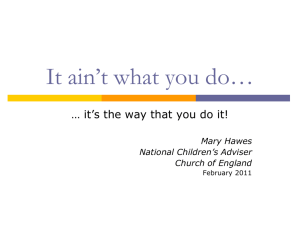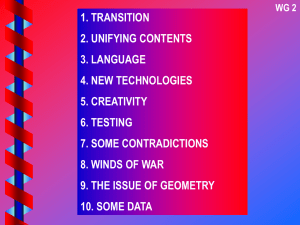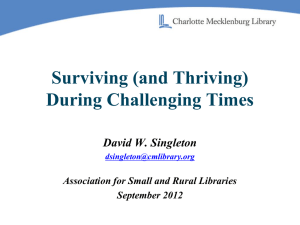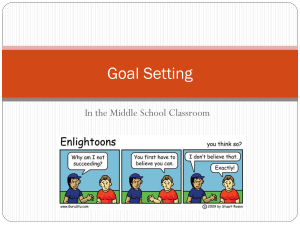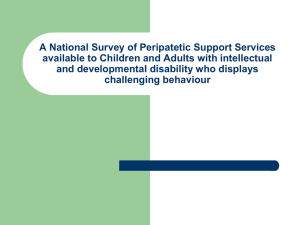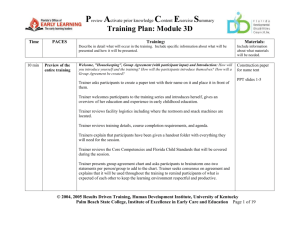Mod 3.3 Replacement Skills
advertisement
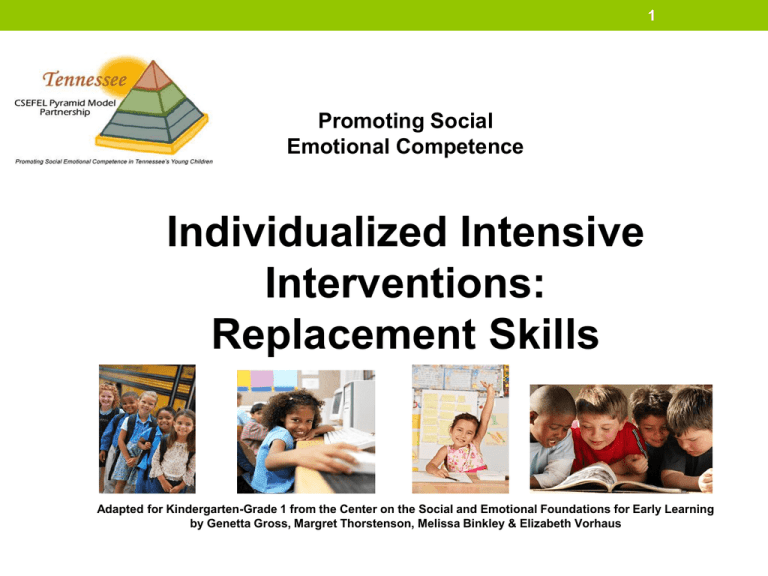
1 Promoting Social Emotional Competence Individualized Intensive Interventions: Replacement Skills Adapted for Kindergarten-Grade 1 from the Center on the Social and Emotional Foundations for Early Learning by Genetta Gross, Margret Thorstenson, Melissa Binkley & Elizabeth Vorhaus 2 3 Challenging Behavior What we are referring to when we say “challenging behavior” is: • Any repeated pattern of behavior that interferes with learning or engagement in pro-social interactions with peers and adults. • Behaviors that are not responsive to the use of developmentally appropriate guidance procedures. • Prolonged tantrums, physical and verbal aggression, disruptive vocal and motor behavior (e.g., screaming, stereotypy), property destructions, self-injury, noncompliance, and withdrawal 4 Why Children Engage in Challenging Behavior • Challenging behavior communicates • Used instead of language by a child who has limited social or communication skills. • Challenging behavior works • Challenging behavior results in the child gaining access to something (i.e., obtain/request/power) or someone or avoiding something or someone (i.e., escape/protest). 5 Behavior Support Plan • Behavior Hypotheses- Purpose of the behavior, your best guess about why the behavior occurs • Prevention Strategies- Ways to make events and interactions that trigger challenging behavior easier for the child to manage • Replacement Skills– New skills to teach throughout the day to replace the challenging behavior • Responses- What adults will do when the challenging behavior occurs to ensure that the challenging behavior is not maintained and the new skill is learned 6 Behavior Hypothesis • Expands on the behavior equation and incorporates what you have learned from observations and interviews • Includes information about: • Function of the behavior • Triggers of the challenging behavior • Description of the challenging behavior • Responses that maintain the challenging behavior 7 Terrance’s Hypothesis Statement To avoid sharing or to maintain solitary use of toys or activities, Terrance uses physical aggression. When children attempt to use toys he has played with or is playing with, Terrance will hit and kick them. Adults remove the injured child from the area and provide Terrance with negative attention (e.g. scolding). Terrance maintains use of the toy or activity. 8 Not Sure About the Hypothesis? • What would make the challenging behavior stop? Is it something you would provide or allow the child to access? Or is there something to remove? Or can you allow the child to leave? • If still unsure, collect more data in the same context. • Some challenging behavior may have the same form but serve multiple functions. • Some challenging behaviors may begin around one function (e.g. escape) and continue to serve another function (e.g. gain attention). 9 Behavior Support Plan • Behavior Hypotheses- Purpose of the behavior; your best guess about why the behavior occurs • Prevention Strategies- Ways to make events and interactions that trigger challenging behavior easier for the child to manage • Replacement Skills– New skills to teach throughout the day to replace the challenging behavior • Responses- What adults will do when the challenging behavior occurs to ensure that the challenging behavior is not maintained and the new skill is learned 10 Teaching Replacement Skills • Teach alternative behavior to challenging behavior. • Replacement skills must be efficient and effective (i.e., work quickly for the child). • Consider skills that child already has. • Make sure the reward for appropriate behavior is consistent. 11 Functional Equivalence • Identify an acceptable way that the child can deliver the same message. • Make sure that the new response is socially appropriate and will access the child’s desired outcome. • Teach the child a skill that honors that function of the behavior (e.g., if child wants out of activity, teach child to gesture “finished”). 12 Escape (e.g., activity, demands, social interaction) Possible Replacement Skills • Request break • Say “No” • Set goals • Say “All done” • Request help • Identify and express • Follow schedule feelings • Use supports to follow rules • Anticipate transitions • Participate in routine • Choice • Self-management 13 Obtain (e.g., attention, object, activity) Possible Replacement Skills • Follow schedule • Request attention • Participate in routine • Choice • Self-management • Ask for a hug • Request help • Ask for a turn • Teach delay of • Ask for item reinforcement 14 Scripted Stories • Scripted stories provide a script for the child about social situations and expectations. • The story is written from the child’s perspective. • The story includes descriptive, perspective, and directive sentences. • The story must match the child’s symbolic and receptive communication level. 15 Scripted Stories 16 Social Skills Instruction • Determine skill to be taught; be specific (what does the behavior look like?). • Ensure that opportunities to teach and practice the skill are available. • Decide on method of instruction (e.g. role play, prompt and acknowledge positive behavior, etc.). • Teach skill. • Provide opportunities to practice skill. • Reinforce skill use in natural contexts. 17 Self-Management • Identify an observable behavior that the child will self- manage. • Visually display behaviors for the child. • Provide instruction to the child on the targeted skill. • Give child a mechanism to monitor engagement in the behavior through a checklist or chart. • Provide positive attention to the child for engaging in the behavior and using the self-monitoring system. 18 When You Can’t Honor the Function of the Challenging Behavior… • Teach tolerance for delay in achieving the reinforcer (e.g. help the child stay engaged by giving a signal about how long to hang in “two more songs, then all done.”) • Provide choices (“You can put a sticker or a stamp on your chart, but you need to take meds.”) • ‘First, then’ contingency (“First, wash hands with the wipes or at the sink. Then, snack.”) • Provide preferred items as distraction (“Sit in car seat; you can have teddy bear or you can have blanket.”) • Teach child to anticipate and participate (e.g. provide a transition warning and a visual schedule so the child can anticipate the transition and actively participate.) 19 Designing Replacement Skill Instruction Procedures • Select a skill to teach. • Select a method of instruction. • Follow steps of instructional procedure systematically. • Teach throughout the day. 20 Activity: Action Planning • Take some time to fill out your Action Plan • Include in your Action Plan: • Identify 1-2 children in your classroom who will benefit from replacement skills • Decide which skills will work best for them • Decide how you will put those skills into action HO : Action Plan 21 Questions?

